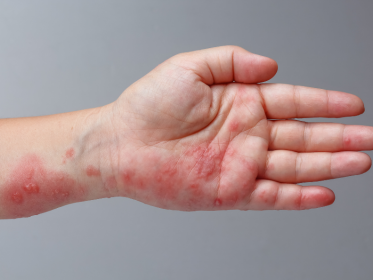- +1 888.407.0616
- info@mdchoicehospicecare.com
- Mon - Fri 9 AM - 5 PM

In short, shingles are a herpes virus. It happens to nearly all the people who have once had chickenpox. Till that, the disease does not manifest itself in any way but as the immune system decreases in the background of other chronic diseases it starts to cause skin pathologies.
Elderly and senile people are more tend to experience shingles as their organism starts to protect itself from a lot of side factors such as slowing metabolism, deterioration, and adaptive activities.
The acquisition of persistent immunity against chickenpox implies the constant presence of the virus in the DNA of neurons. In the sleeping state, it does not affect the body. However, under favorable conditions, the active reproduction begins and manifests itself as shingles.
In addition to a decrease in immunity, factors that provoke the onset of the disease may be stress, constant fatigue, surgery, or taking certain medications.

The areas of the greatest accumulation of the pathogen are large nerve ganglia. It is there that all the symptoms of pathology are manifested on the skin. Often these are areas of innervation of the trigeminal nerves. It is necessary to understand that not only the skin is affected, but also the nerves which can lead to serious consequences in the form of vision loss, nerve paralysis, brain disorders, etc.

As a matter of fact, the shingles virus isn’t transmitted from a person to another. Activation of the virus usually occurs against the background of weakening of the cellular link of immunity and the impact of adverse factors such as hypovitaminosis, hormonal drugs, radiation, diabetes, etc. Mainly women and the elderly are prone to relapses of shingles. Statistics of the latest WHO research show that nearly 80% of the world’s elderly have suffered from shingles.
The onset of the disease is quite pronounced as there is a burning sensation and soreness of a certain area of the skin. Often these areas coincide with the location of the trigeminal facial nerve and thus affect the forehead, neck, etc.
In reality, the disease can have two ways of development- typical and atypical. With an atypical form, the symptoms may be mildly pronounced, while during the atypical form there are no rushes and there is a single focus area.
As a matter of fact, the disease may have individual forms of development, however, the World Health Organization has formed a general symptoms list. Thus, whenever a shingle is developed, the person may have the following symptoms;
If you’ve any of these symptoms, don’t hesitate to see a doctor. First of all, it’s recommended to consult a therapist who will direct you to an infectious disease specialist and dermatologist. In severe cases, you may need to consult a neurologist as well. Shingles require thorough care. Patients may need not only physical but also psychological help. Try to help your loved ones by being by their side. Don’t try to treat them without consulting a doctor.